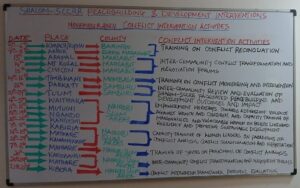
The winding Tana River.
By Joyce Wamae
Tana River County, once the Coast province of Kenya has a population of approximately 262, 684 according to the 2012 census and covers an area of approximately 35,375 square kilometres. The County borders the Counties of Kitui, Garissa, Isiolo, Lamu and Kilifi. The area is named after the Tana River, the longest river in Kenya (approximately 500km long) that rises in the Aberdare Mountains in Central Kenya and drains into the Indian Ocean along the Coast. The County has three sub counties or Constituencies; Bura, Galole and Garsen. The main ethnic groups in the County are the Pokomo, many of whom are farmers, and the Orma and Wardey who are mainly nomadic pastoralists. Other local tribes include the Wailwana, Waata, Boni and Bajui. The area is also the home of other Kenyan ethnic groups like the Kikuyu, Kisii, Taita, Kamba, Luo, Giriama and some Somali immigrants.

Tana River County in Kenya.
Shalom was requested to conduct various training workshops geared towards peacebuilding for the empowerment of the community in a sub-location or division called Wenje. Wenje is approximately 151km from Mpeketoni, where more than 60 people were attacked by the Al-Shabaab militant group in 2014, and approximately 104km from Lamu County. Wenje lies within one of the four wards of Galole Constituency; Kinakomba Ward. The ethnic groups found in this division are the Orma, Warde, Pokomo and Somali, most of whom are Muslim and were all represented in the workshop.

SCCRR facilitator listens to one of the participants narrate some of the causes of conflict.
Shalom’s workshop was geared towards understanding the history that explains the root causes of the conflict in the area, the context in which it takes place, the parties involved and the dynamics that the conflict takes. Some of the causes of conflict that were reported included tribalism, boundary disputes, political incitement, little access and availability of water and pasture. As interaction with the group continued, it became apparent that the farming and pastoralist communities clashed over the same resources that sustain their livelihoods; water and land/pasture.
The participants proposed that there was need to begin speaking openly about peaceful methods of resolving their disputes. This led them into the formulation of their action plan which was mainly to work with local Chief during their monthly baraza’s (community meetings) and use this platform to speak about the intentions of the group with regard to re-building inter -ethnic relationships. The community members acknowledged that change in attitude will be slow but also stressed the importance of laying a strong foundation that would not only require commitment, but also the input of the community as a whole.

The participants from the workshop in Wenje.
This was the first of a number of workshops which SCCRR will conduct with these communities where local conflict management systems will be strengthened by input from SCCRR. We are committed to the long-term process of transformation that incorporates many different strategies and approaches, which will be designed in collaboration with the communities involved and after key research is completed. We believe that peace is the greatest instrument for development that any person can have and this can only be achieved if the underlying causes of conflict are addressed. SCCRR is looking forward to future engagement with these communities to build a path to peaceful co-existence.

